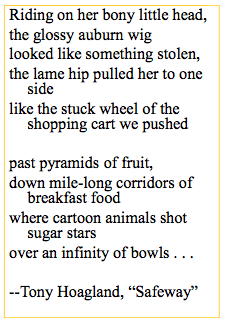What is an image anyway? Well, I can tell you that it’s more than just a visual. It’s more like something that can be touched, heard, and smelled in addition to being seen; otherwise, it would simply be a picture. How does one convey imagery? One way is through sensory details—details that engage the reader’s five senses. You should strive to create images that draw the reader into your work. Effective images are typically vivid, specific, and significant—tools writers use to develop setting, characters, and tone of the creative work. Example from Tony Hoagland’s “Safeway”:

See how he connected the imagery of the woman to the whole supermarket idea? Then a supermarket to something glamorous? It’s beautiful. It’s art. It’s what we should strive to do.
Sensory details provide us with a means of conveying a unique quality about a person or thing, even something intangible, to help us understand something (or someone) in greater depth. Use similes, metaphors, and personifications to suggest new relationships between things, comparisons that ask the reader to see the world differently.
As a writer, you should constantly watch your surroundings. Be completely in tune with everything that is happening. For an example, say you’re pouring yourself a cup of coffee in the morning. Thing of the calming sound of coffee being poured into a mug. The wafting aroma that curls warmly into your nose. The tinkering of the glass. The initial burn of the first sip, followed by the gratuitous taste of the liquid. See how I integrated the senses here? It’s the details that immerse someone into a piece, they drink it up just like that mug of coffee. Writing these details is much like watching a movie in the theater. At first you’re distracted by the stinky man who’s sitting in front of you, huffing and puffing, scratching his head. Your friend next to you slurping her drink. The lights lining the sides of the room. The red dots marking the exit. The feeling of popcorn lodged in your teeth. Then, when the movie starts rolling, you suddenly forget about your own issues and your surroundings and let yourself become absorbed in film. With all the visuals and frames, panning affects, and use of focus, the filmmakers show you what they want you to see, be it a note secretly tucked into someone’s pocket, or a house slowly burning away into nothing. Those small moments that you remember in a film are typically scenes that strike cords with you. In order to achieve such feats in writing, you must use sensory imagery. Make the reader feel the scene with every letter and every keystroke.

